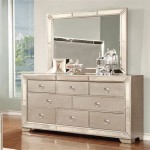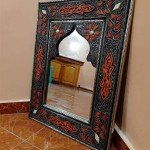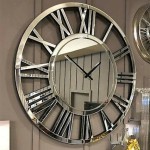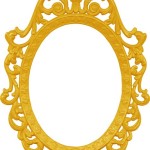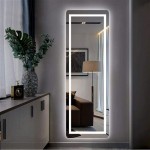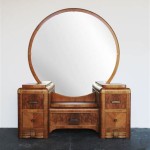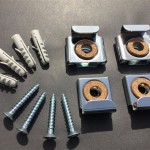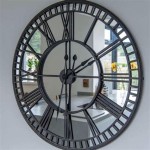Adding a Frame to a Wall Mirror
A frame can dramatically enhance the aesthetic appeal of a wall mirror, transforming it from a simple functional object into a decorative piece. Framing a mirror can also tie it into a room's overall design scheme, complementing existing décor and adding a touch of personalized style. Whether working with a plain, bevelled, or uniquely shaped mirror, numerous framing options are available.
Several factors influence the choice of frame. These include the mirror's size and shape, the existing room décor, and the desired overall effect. A large, ornate mirror might benefit from a simple, understated frame, while a smaller, simpler mirror could be enhanced by a more elaborate design. The frame material also plays a significant role. Wood, metal, and composite materials each offer unique aesthetic qualities and levels of durability.
Wood frames offer classic appeal and versatility. They can be carved, painted, stained, or gilded to achieve a wide range of styles, from rustic to contemporary. The type of wood also contributes to the frame's overall look. Oak and mahogany offer rich, traditional aesthetics, while lighter woods like pine and maple provide a more casual feel. Wood frames can be easily customized to match existing furniture or woodwork.
Metal frames offer a sleek, modern look. Materials like aluminum and stainless steel provide a minimalist aesthetic, while wrought iron and brass can add a touch of elegance and sophistication. Metal frames are generally more durable than wood and are less susceptible to damage from moisture or temperature fluctuations. This makes them a good choice for bathrooms or other high-humidity areas.
Composite frames offer a cost-effective and lightweight alternative to wood or metal. These frames are often made from molded plastic or polyurethane and can be designed to mimic the look of natural materials. Composite frames are also highly resistant to moisture and insects, making them a practical choice for various environments.
Before beginning the framing process, accurate measurements are crucial. Precisely measure the mirror's dimensions to ensure a proper fit. When purchasing a pre-made frame, these measurements will guide the selection process. When building a custom frame, accurate measurements are essential for cutting the frame materials to the correct size.
Several methods exist for attaching a frame to a wall mirror. Adhesive is a common choice for lighter frames. Construction adhesive or specialized mirror adhesive can provide a strong bond between the frame and the mirror. Ensure the adhesive is compatible with both the frame material and the mirror backing. Clamps can be used to hold the frame in place while the adhesive dries.
For heavier frames, mechanical fasteners may be necessary. Small L-brackets or clips can be used to secure the frame to the mirror. These fasteners are typically attached to the back of the frame and the edge of the mirror. Screws are then used to secure the brackets or clips in place. This method provides a more secure hold and is ideal for larger or heavier mirrors.
Another framing method involves building a frame around the mirror directly on the wall. This method works well for large mirrors or mirrors already mounted on the wall. The frame pieces are cut to size and attached directly to the wall around the mirror's perimeter. This method allows for greater flexibility in frame design and can accommodate intricate or unconventional shapes.
Safety should always be a primary concern when working with mirrors and framing materials. Wear appropriate safety glasses to protect eyes from dust and debris. Gloves can protect hands from sharp edges and splinters. When cutting materials, ensure adequate ventilation to prevent the inhalation of dust particles. If using power tools, follow all manufacturer safety guidelines.
Finishing the frame adds the final touch to the project. Wood frames can be painted, stained, or varnished to achieve the desired aesthetic. Metal frames can be polished or left with a natural patina. Composite frames often come pre-finished but can be painted if desired. The chosen finish should complement the mirror and the surrounding décor.
Proper installation ensures the framed mirror remains securely in place. Use appropriate wall anchors and screws for hanging the framed mirror. The type of anchor required depends on the weight of the mirror and the wall construction. Consult a hardware professional to determine the best anchor for the specific application. Ensure the mirror is level and securely fastened to the wall before releasing it.
Framing a wall mirror is a relatively straightforward project that can significantly enhance a room's aesthetic appeal. By carefully considering the factors discussed, individuals can select the appropriate frame material, attachment method, and finish to create a beautiful and functional piece that complements their personal style and existing décor.

How To Frame Out That Builder Basic Bathroom Mirror For 20 Or Less

Diy Stick On Mirror Frame Sawdust Sisters

How To Frame A Mirror

Diy Stick On Mirror Frame Sawdust Sisters

How To Frame Out That Builder Basic Bathroom Mirror For 20 Or Less

Diy Framed Mirror

How To Build A Diy Frame Hang Over Bathroom Mirror Love Our Real Life

Diy Picture Frame Trim On A Frameless Mirror Chris Loves Julia

Diy Mirror Frame Ideas How To A In 8 Steps Architectural Digest

Frame In A Bathroom Mirror With This Tutorial Large Mirrors Diy Simple

